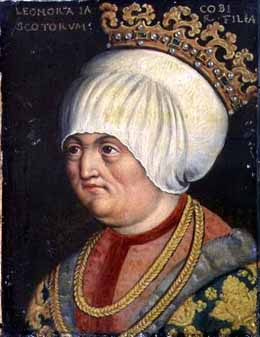|
Reviews index
March 4th 2014
Eleanor of Scotland and Duke Sigmund of Tyrol
a talk by Andrew Milne –Skinner
Andrew Milne-Skinner first became interested in Scottish connections with Tyrol, when he read about Eleanor of Scotland in Nina Murdoch’s Tyrolean June. He went on to discover a figure of Eleanor in the Basilica in Stams and motifs and carvings in Seefeld and Schloss Tirol, which depict the Scottish Coat of Arms.
 In this fascinating historical talk Andrew asked the question ‘Why are these Scottish connections here in Tyrol?’ The answer lies in the marriage, in 1448, of Sigmund Duke of Tyrol to Princess Eleanor, daughter of King James I of Scotland. In this fascinating historical talk Andrew asked the question ‘Why are these Scottish connections here in Tyrol?’ The answer lies in the marriage, in 1448, of Sigmund Duke of Tyrol to Princess Eleanor, daughter of King James I of Scotland.
Sigmund , known as ‘the Rich-o’-Coin’ (der Münzreiche) derived his wealth from the silver mines of Schwaz and coins were minted with Tyrolean silver as far afield as England. The Habsburgs used Tyrol as a centre for European connections, strengthened by strategic marriages. Sigmund should have married Radegunde, daughter of the French King but unfortunately she died and instead he married Eleanor of Scotland.
Scotland also had a high standing in the courts of Europe. James I’s eldest daughter married the Dauphin of France in 1436 continuing a connection called ‘the Auld Alliance’.
After the death of her parents, Eleanor was brought up at the French Court and the diplomatic marriage with Sigmund, in 1448, was negotiated by her brother James II, with the assistance of the King of France. Interestingly, in her marriage contract, Eleanor received 3 castles: Ambras, Imst and Hertenberg and income from Kaltern, the Saline in Hall and the customs station at Lueg, Brenner.
Andrew took us on the long route of the marriage trip through Europe to Tyrol, following Eleanor’s journey to her final destination in Meran.
The Scottish princess lived some 31 years in Tyrol and her gentle manners, literary gifts and interest in sport made her widely popular. Her relationship with Sigmund, however, was distanced. They spent much time apart and she did not succeed in bearing him a surviving male heir. She pursued literary and artistic interests while Sigmund devoted himself to the hunt or other extra-marital activities (he is said to have had at least 40 illegitimate children).
Sigmund’s cannon foundry and armourers were famed throughout Europe and in 1486,he introduced the siver coinage the Thaler, later known as the dollar. Unfortunately Sigmund’s lavish life-style almost bankrupted Tyrol and his bankers, the Fuggers did not discourage him as it provided them with huge profits ( clearly no modern occurrence).
Eleanor died in 1480, Sigmund in 1496, in Innsbruck and both are buried in Stams where their gilded figures can be seen in the crypt of the Basilica.
We thank to Andrew for this most interesting and informative talk. I am sure that next time we visit Stams or Seefeld or Schloss Tirol we will look out for motifs representing Scotland and understand why they are there.
Lynne Hilber
Reviews index
------> next review
|
|
 |
| We are starting our Winter Season on 10th September |
|
|
|
 |
|
 |
|
 |
|
|









